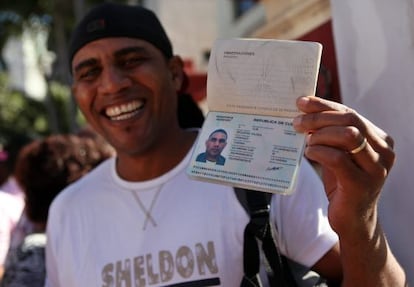Some 184,000 Cubans take advantage of relaxed travel rules during first year
Brain drain feared by Castro government has not occurred

Exactly one year after the Cuban government relaxed foreign travel policies for its citizens, more than 184,000 islanders have gone abroad – many have taken more than one trip – mainly to the United States, Mexico and Spain.
According to official figures, 3,500 Cubans who had been living in other countries have returned to the island to stay. Nevertheless, Havana continues to tightly control the return of hardline critics of the Castro regime -- though it does grant them permits to temporarily visit the island.
And so far, there has been no mass exodus of the country’s intellectuals or scholars as had been feared by the Cuban government.
President Raúl Castro introduced the new travel rules, which went into effect last January, as part of his series of reforms aimed at modernizing the Cuban economy. But it is still not an easy task for all Cubans to travel abroad.
Regulations call for prior exit approval, known as the “white paper,” by the government and travelers have to demonstrate they have enough money to cover their expenses, including the cost of the airline ticket, visas and expenditures abroad.
Some of those who cannot fulfill the requirements still resort to the dangerous practice of building rickety rafts and boats and trying to cross the shark-infested waters to reach the Florida Keys or nearby Caribbean nations such as Haiti and Jamaica.
According to figures released by the government’s foreign and migration department, Cubans made 257,518 trips abroad from January 14 to November 30 last year. “These were trips made by 184,787 people, which means that within this period some people took a trip more than once,” said department chief Lamberto Fraga.
Among the high-profile Cubans who were able to leave last year were dissidents Berta Soler, the head of the Ladies in White; Guillermo Fariñas, Patriotic Union of Cuba spokesman; human rights activist Jorge Luis García Pérez; and the bloggers Eliécer Ávila and Yoani Sánchez, who had previously been denied exit permits.
But they were forced to return when government officials began cracking down on their colleagues and the organizations they represent. In the last quarter of 2013, there were an estimated 931 illegal arrests, according to the Commission for Cuban Human Rights and National Reconciliation. On January 6 of this year the commission reported around 30 temporary detentions of dissidents.
While Castro’s government has not released precise details, the travelers tend to be young professionals aged between 25 and 40, who sometimes go in search of jobs abroad. The reform allows travelers to stay abroad for up to two years without losing their residency or the modest social benefits to which they are entitled.
While the relaxed policies have benefited many Cubans, Washington and Havana are still too at odds on many issues to initiate talks on migration. The United States is pushing for the release of US contractor Alan Gross, who was given a jail sentence after he was discovered delivering telephones and radios to dissident groups. At the same time, Havana is demanding that US officials release four Cubans – part of the so-called Cuban Five – who are serving time in the United States for espionage.
But the flow of travelers from the United States to Cuba has also picked up. Since January 2013, the telephones at the Marianao Travel agency in Miami have been ringing every day with potential customers calling to ask about prices and information on obtaining Cuban visas.
“All of the balseros [those who arrived in United States on rafts and boats] who left after 1994 have been traveling back to Cuba as well as the physicians who deserted their country and faced prosecution,” said one worker, Maite.
Since President Obama eased travel restrictions in 2009, 15 US airports have been authorized to handle charter jets to and from Havana.
But airports in Florida, mainly Miami, Tampa, Fort Lauderdale and Key West, are also cashing in with direct flights not only to Havana but also to Villa Clara, Holguín, Cienfuegos and Santiago de Cuba.
Tu suscripción se está usando en otro dispositivo
¿Quieres añadir otro usuario a tu suscripción?
Si continúas leyendo en este dispositivo, no se podrá leer en el otro.
FlechaTu suscripción se está usando en otro dispositivo y solo puedes acceder a EL PAÍS desde un dispositivo a la vez.
Si quieres compartir tu cuenta, cambia tu suscripción a la modalidad Premium, así podrás añadir otro usuario. Cada uno accederá con su propia cuenta de email, lo que os permitirá personalizar vuestra experiencia en EL PAÍS.
¿Tienes una suscripción de empresa? Accede aquí para contratar más cuentas.
En el caso de no saber quién está usando tu cuenta, te recomendamos cambiar tu contraseña aquí.
Si decides continuar compartiendo tu cuenta, este mensaje se mostrará en tu dispositivo y en el de la otra persona que está usando tu cuenta de forma indefinida, afectando a tu experiencia de lectura. Puedes consultar aquí los términos y condiciones de la suscripción digital.
Últimas noticias
The complicated life of Francesca Albanese: A rising figure in Italy but barred from every bank by Trump’s sanctions
From digital curfews to blocking apps: How technology experts protect their children online
Why the price of coffee has skyrocketed: from Brazilian plantations to specialty coffee houses
Confined to a Cuban hospital: When electricity is a matter of life or death
Most viewed
- Pablo Escobar’s hippos: A serious environmental problem, 40 years on
- Why we lost the habit of sleeping in two segments and how that changed our sense of time
- Trump’s obsession with putting his name on everything is unprecedented in the United States
- Charles Dubouloz, mountaineering star, retires at 36 with a farewell tour inspired by Walter Bonatti
- The Florida Keys tourist paradise is besieged by immigration agents: ‘We’ve never seen anything like this’









































